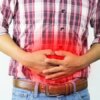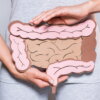
Gut Health and Constipation
Constipation is often a long-term and chronic digestive symptom which impacts a significant percentage of the global population. Constipation is typically characterised by infrequent bowel movements but can also involve additional symptoms which can vary in their presentation.
The additional symptoms can include:
- Stomach pain
- The feeling of an incomplete bowel movement
- Excessive straining
- A long time spent on the toilet
- Hard consistency of the stool
- Abdominal bloating and/or distention
Often laxatives are used to help support bowel movements to address constipation. However, another approach can be to work to identify and treat the underlying cause of the constipation and gut symptoms. [Source: PubMed]
Causes of Constipation
Constipation can be classified into 2 main types of constipation.
- Primary constipation
- Secondary constipation
Primary constipation refers to the dysregulation or discoordination of the bowel. This may be considered as an issue with the muscle contractions in the bowel itself which impacts bowel movements.
Primary constipation can often then be described as:
- Functional defecation disorder
- Slow transit constipation
- IBS-C (IBS with constipation)
Secondary constipation is caused by factors that then lead to poor bowel function. These are wide-ranging and can include:
- Metabolic issues (hypothyroidism, hypercalcemia)
- Medications (opiates, antipsychotics)
- Neurological disorders (Parkinsons, diabetes)
- Diseases of the gut (cancer, proctitis, strictures)
When working to address constipation and the stomach pain that may be present also, treating the underlying issue is an important consideration. [Source: PubMed]
What Constipation Pain Feels Like
A central symptom of constipation is pain and discomfort. This can vary in location but can commonly be in certain regions. For many, constipation can feel like:
- Pain in the rectum and anus
- Pain in the lower left side of the abdomen
- Pain or discomfort across the abdomen
While the pain from constipation in the abdomen may feel like stomach pain, it can be from the small or more commonly the large intestine.
There can also be increased pain or discomfort when passing a stool. This can be due to the stool being harder to pass. Often this leads to straining and irritation in the gut wall. [Source: PubMed]
Constipation pain and also lead to a symptom called tenesmus. This is commonly caused by irritated nerves sending the sensation that more stool needs to be passed. This may lead to someone an increased urge to pass a stool without a bowel movement occurring. This is also an often distressing and painful symptom. [Source: PubMed]
Is Constipation the Same as IBS?
While constipation can be a symptom of IBS, (termed IBC-C) it can also be present as a single symptom. This is because for a diagnosis of IBS pain is a required symptom. Often with constipation, pain is not always present.
Without the presence of pain, the constipation can often be diagnosed as functional constipation. The diagnostic criteria for this condition must include two or more of the following:
- Straining during more than ¼ (25%) of defecations
- Lumpy or hard stools (Bristol Stool Form Scale 1-2) more than ¼ (25%) of defecations
- The sensation of incomplete evacuation of more than ¼ (25%) of defecation
- Sensation of anorectal obstruction/blockage more than ¼ (25%) of defecations
- Manual manoeuvres to facilitate more than ¼ (25%) of defecations (e.g., digital evacuation, support of the pelvic floor)
- Fewer than three SBM per week
- Loose stools are rarely present without the use of laxatives [Source: ROME Foundation]
How to Fix Constipation
First-line approaches to treat constipation can be implemented without further tests.
These include:
- Dietary changes
- Lifestyle adjustments
- Increasing fibre intake
- Ensuring appropriate water intake
- Regular exercise and movements [Source: PubMed]
These adjustments and modifications can be implemented to start to address and support bowel function. Following this, particularly if no improvements in bowel movements or stomach pain have been noted, there are further considerations.
These include:
- Bulk-forming laxatives
- Stool softeners
- Prunes [Source: PubMed]
While laxatives can support a bowel movement to improve gut symptoms. There will not be addressing the underlying issue in the bowel. However, they can be a helpful form of support to put in place to improve comfort alongside treatment.
These include osmotic laxatives such as:
- PEG compounds
- Lactulose
- Magnesium-containing laxatives [Source: PubMed]
Further nutritional considerations that can be considered to address the root cause of constipation and stomach pain include:
- Methane SIBO (IMO) [Source: PubMed]
- Food intolerances [Source: PubMed]
- Decreased vagal tone [Source: PubMed]
- Microbiome dysbiosis [Source: PubMed]
How do You Stop a Stomach-ache from Constipation?
Often if the stomach pain is caused by constipation and the stool (poo) in the digestive system, going to the toilet can be the first step to relieving stomach ache from constipation.
Some of the quickest ways to go to the toilet are prunes as well as laxatives such as magnesium and lactulose. Often the dose of these needs to be increased slowly over some time to achieve a bowel movement.
Additionally, herbal teas such as peppermint, caraway and anise can help to relieve abdominal discomfort and pain. In particular, peppermint as this can calm oversensitivity nerves along the digestive tract. These over-sensitive nerves are referred to as visceral hypersensitivity and are commonly present in gut conditions such as IBS and constipation. [Source: PubMed]
Can Constipation Cause Horrible Stomach Pain?
Constipation can be a common cause of stomach pain and abdominal discomfort.
However, this pain may not be stemming from the stomach itself. It is likely originating from the end of the large intestine.
The large intestine is where fluid is absorbed into the body where stool is stored before it is excreted. In cases of constipation, this stool accumulates in the bowel placing pressure on the wall of the large intestine.
Along with the increased amount of stool and pressure on the bowel wall, it’s common for the nerves to be very sensitive in the bowel. As mentioned, this is referred to as visceral hypersensitivity.
Therefore, in constipation, it can be that there is an increased amount of stool in the bowel combined with increased nerve sensitivity. These can lead to increased levels of pain, stemming from the digestive system. [Source: PubMed]
What Drinks are Good for Constipation?
One of the best drinks for constipation is prune juice. This contains a high amount of fibre which can support bowel movements. A single glass of prune juice can contain 10% of our daily fibre requirements.
Additionally, prunes and prune juice contain sorbitol. This is a type of sugar that when consumed in high enough amounts can have a stool-softening effect, improving constipation. [Source: PubMed]
Lactulose is another stool softener that is in liquid form. This is a drink that is available over the counter and often prescribed by doctors to improve constipation. In some, this may trigger bloating. [Source: PubMed]
Coffee is a commonly used drink to help go to the toilet to improve constipation. This is because of coffee and how it stimulates the bowel walls. In those with IBS and a sentience stomach, this may not be well tolerated. [Source: PubMed]
Constipation and Stomach Pain – Conclusion
Stomach pain can be the result of chronic constipation, but it can also be caused by IBS.
Laxatives and stool softeners may improve bowel movements and help the passing of stool to improve symptoms, however, they will not address the underlying cause of the constipation.
Working with a registered gut health specialist and being a key part of the support process. This is to understand and address the underlying cause of the symptoms, a key factor when creating a treatment protocol.






